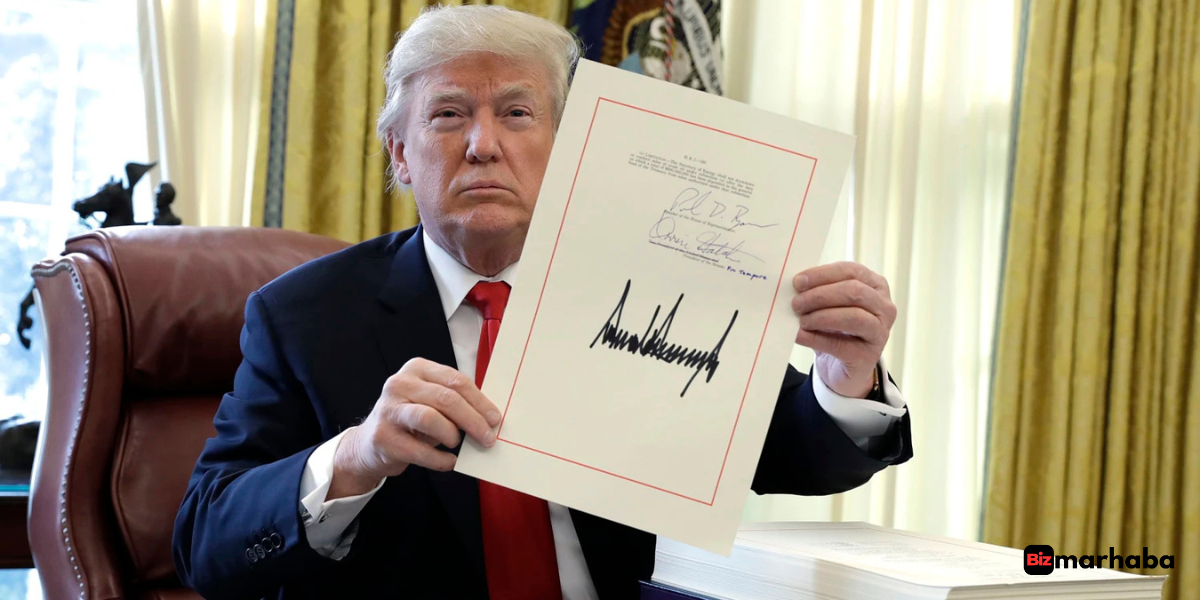Donald Trump signed his “One Big Beautiful Bill” into law on July 4, 2025. He stood before cheering supporters and called it the biggest tax cut in United States history. The message was bold, and the branding was classic Trump. But when economists crunched the numbers, they found a different story.

Independent analysts agree: the law is not the largest tax cut on record. Instead, it ranks third since 1980, behind Ronald Reagan’s sweeping 1981 cuts and Barack Obama’s 2012 deal. That gap between political claims and economic reality has fueled heated debate in Washington and beyond.
The Scale of the Law
The new law makes Trump’s 2017 tax cuts permanent. It also introduces fresh breaks on tips, overtime pay, child care, and retirement savings. Budget experts say the measure will cost between $4–5 trillion in lost revenue over the next decade.
Measured against the economy, the law trims revenue by about 1.4% of GDP over five years. That number puts the Trump tax cuts in third place since 1980. Reagan’s plan hit 2.9%, Obama’s came in at 1.8%.
So while Trump called it “the biggest ever,” the data shows otherwise.
The Fight in Congress
The road to passage was messy. After weeks of fiery debate, the house of representatives passes Trump tax-cut bill, which became the headline in July 2025. It squeaked through with a narrow Republican majority.
From there, the action shifted to the Senate. The vote was tense, but in the end, senate republicans approve trump’s tax cuts. The victory gave Trump his July 4th signing ceremony, a moment designed for headlines and campaign ads.
Who Gains the Most?
The benefits of the new law aren’t spread evenly. Analysts say around 70% of the relief goes to the top 20% of households. The richest Americans see the largest gains, with the top 1% pocketing an average of $66,000 a year in tax breaks.
Middle-class families get smaller cuts. For the poorest households, the picture looks worse. They get only about 1% of the relief, and many will lose Medicaid or food aid that once cushioned their budgets.
Overtime and Paychecks
For many workers, the big question was, did Trump cut taxes on overtime? The answer is yes. The bill makes overtime wages tax-free starting in 2026.
This provision, known as Trump tax cuts on overtime, was pitched as a way to reward hard work. Hotel staff, nurses, and retail workers stand to benefit the most. The White House promoted it as proof the law helps “ordinary Americans, not just the wealthy.”
But experts caution that not all workers regularly earn overtime. For many families, the relief may feel smaller than the headlines suggest.
Medicaid and Social Programs on the Chopping Block
The other side of the bill is spending cuts. Medicaid, the program that covers millions of low-income and disabled Americans, loses about $1–1.2 trillion in federal funding. Experts predict 10–12 million people could lose coverage.
Food assistance also faces deep reductions. Families relying on SNAP benefits may find themselves squeezed even further. Critics say this trade-off—big relief for the rich, less support for the poor—sends the wrong message about national priorities.
Ripple Effects Across the States
Because Medicaid funding is shared between federal and state governments, states will feel the pressure. Some may hike taxes or trim local services to fill the gap. Others may cut back on education, healthcare programs, or infrastructure projects.
The result? Unequal impacts. Wealthier states can cushion the blow, but poorer ones may be forced to make painful cuts. That could deepen inequality between regions.
Supporters’ View
The Trump administration calls the law a major victory for working families. By removing taxes on tips, overtime, and raising deductions, they argue workers will take home more of their paychecks.
Republicans say the plan rewards effort, strengthens family finances, and keeps businesses competitive. They believe lower taxes will encourage investment and long-term growth.
For Trump, the bill is also about legacy. He wanted a signature achievement for his second term, and this law delivered it.
Critics’ Concerns
Democrats and many independent economists tell a different story. They warn the bill heavily favors the wealthy and undermines essential safety nets.
The fiscal risks also loom large. The U.S. deficit is already high, and slashing trillions in revenue could strain future budgets. Borrowing costs may rise, leaving less room for investments in schools, roads, or healthcare.
In their view, the law creates short-term political wins but long-term economic problems.
How It Stacks Up Against History
Comparing it to earlier tax reforms shows the gap. Reagan’s 1981 cuts redefined tax policy and remain the largest. Obama’s 2012 deal locked in much of George W. Bush’s tax plan while expanding relief for the middle class.
By contrast, Trump’s 2025 law builds on his own 2017 cuts and adds new breaks. It is large, yes but not the largest. Independent analysis is clear: Trump tax cuts rank third in history, behind Reagan and Obama.
Conclusion
The new law is historic in scope and impact. It reshapes taxes, trims social spending, and shifts resources toward higher-income households. For workers, it offers benefits like tax-free overtime. For the poorest, it removes lifelines like Medicaid and food aid.
Trump can claim a major legislative win. But the numbers tell their own story. Despite the celebration, his “One Big Beautiful Bill” is not the biggest tax cut ever. It lands in third place, trailing the giants of Reagan and Obama.








